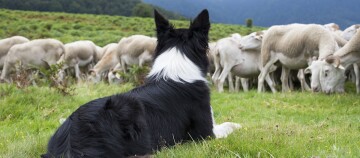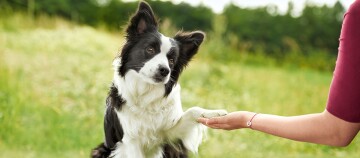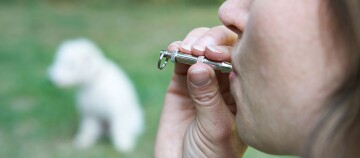Newfoundland – the big dog and the sea
27.02.2024 - Reading time: 8 minutes
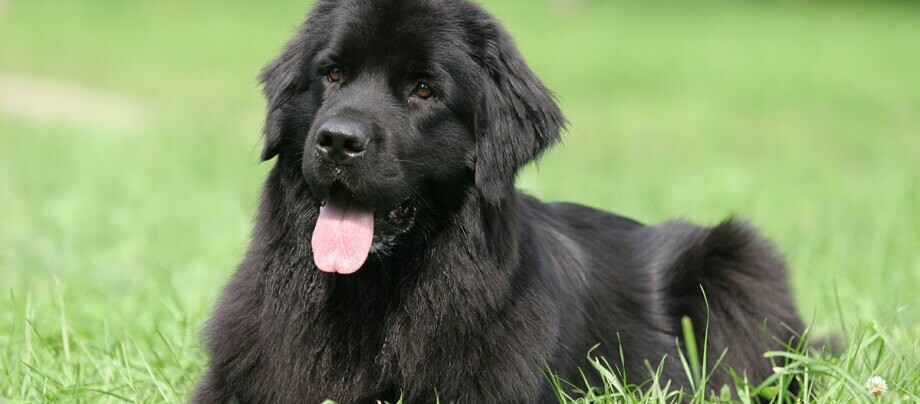
Impressive, cuddly and unbelievably gentle: The Newfoundland, which looks a bit like a bear, is a loving companion. To give it an appropriate home, you need a lot of space and should give the cuddly Canadian dog plenty of attention. If you live by the sea or at least near water, then you may have found the perfect dog in the Newfoundland.
- Viking ships and fishing boats
- Character: What are the characteristics of a Newfoundland?
- Newfoundland profile
- Is a Newfoundland ideal for first-time owners?
- How large and heavy do Newfoundlands become?
- Training and looking after a Newfoundland
- Is a Newfoundland a family dog?
- How much does a Newfoundland puppy cost?
- Where can you buy a Newfoundland?
- Rescues and Newfoundland mongrels
- Taking care of a Newfoundland
- What to be aware of when feeding your Newfoundland puppy
- How old do Newfoundlands become?
Viking ships and fishing boats
Where do Newfoundland dogs actually come from? Around a thousand years ago, the Vikings landed on the coast of Newfoundland. They were joined by huge, bear-like dogs, some of which stayed on the island and came across dogs from the native Indian inhabitants after their Nordic seafarers departed. The next settlers emerged in the 17th century and had their own animal companions with them. Cross-breeding this dog with the descendants of Viking dogs led to a bear-like dog – a powerhouse that did amazing things on fishing boats as a sledding and working dog. Water has remained its element. Legend has it that a Newfoundland saved Napoleon from drowning while he was fleeing Elba. Thanks to its love of water and strength, the Newfoundland is a lifeguard par excellence – including most officially with the French coastguard.
Character: What are the characteristics of a Newfoundland?
Inside the Newfoundland, you’ll find the heart of a true angel on four paws, which is known for its good nature, peaceableness and patience. The intelligent and hard-working dog also has a peaceful and balanced nature, is known for being child-friendly and has a heightened rescue instinct. As water and rescue dogs, Newfoundlands are highly sought-after working dogs, and for good reason. The Newfoundland is also extremely devoted and affectionate. It is a teddy bear that forms close connections with its owners and loves to be around others.
NewsletterNewfoundland
Breed | Newfoundland |
Origin | Canada |
Classification | Molossian, pinscher and schnauzer |
Size | Male 69 to 74 centimetres – female 63 to 69 centimetres |
Weight | Male 60 to 70 kilograms – female 45 to 55 kilograms |
Physique | large, strong, bearlike, solid body with droopy, long tail |
Eyes | almond-shaped, dark brown |
Ears | triangular and close to the body, relatively small, rounded tip |
Coat and colour | moderately long, dense fur with soft undercoat; colour black-white, brown or black |
Special features | water-repellent grease film in fur |
Character | intelligent, good-natured, loves children, protective and rescue instinct, devoted and loves affection |
Care | comb and brush often, bathe rarely |
Health | predisposition to hip and elbow dysplasia, heat sensitivity, disposition to bone cancer and heart problems |
Is a Newfoundland ideal for first-time owners?
The Newfoundland is known for its extremely peaceful, patient nature. It shows no signs of aggression. Its friendly and peaceful character make it easy for even first-time owners to raise. But the Newfoundland can be somewhat stubborn, which is worth taking into account when raising it. Even if the Newfoundland is generally well-suited to first-time dog owners, it is advisable to visit a dog school even while it is a puppy. This allows you and your dog to learn about living together right from the start. To keep your Newfoundland even-tempered and satisfied, it takes more than just consistent and patient training. It is also important to know all the needs of this breed and that you can give it what it needs.
Training and looking after a Newfoundland
So you’re wondering: “Who is a Newfoundland suitable for? “ One important answer to the question is clear: Anyone who wants to keep a Newfoundland needs space. The huge Newfoundland will not feel at ease in an apartment. Taking care of a Newfoundland properly requires space and time to give the animal plenty of freedom and activity. A house with a garden, ideally close to nature, is ideal for a Newfoundland. The Newfoundland’s thick fur makes it very sensitive to heat. On hot days, make sure therefore that the dog always has access to somewhere in the shade and a chance to cool down.
For your Newfoundland, it is also essential that it has enough to do: Newfoundlands desire physical and intellectual stimulation in wind and weather. For example, dog dancing or obedience may be an enjoyable activity for the both of you. If possible, plan excursions to the water with your Newfoundland. With suitable bodies of water (no current!), it will love fetching objects out of the water. Last but not least, a Newfoundland is, of course, an excellent working dog, such as for water rescue. Even if the Newfoundland seems modest due to its peaceful, quiet nature, your care and attention is a must! If neglected, behavioural abnormalities may result, bringing problems.
How large and heavy do Newfoundlands become?
The average Newfoundland male has a shoulder height of 71 centimetres, while females reach around 66 centimetres – an impressive size. The average weight of a Newfoundland male is between 60 and 70 kilograms, with females weighing up to 55 kilograms.
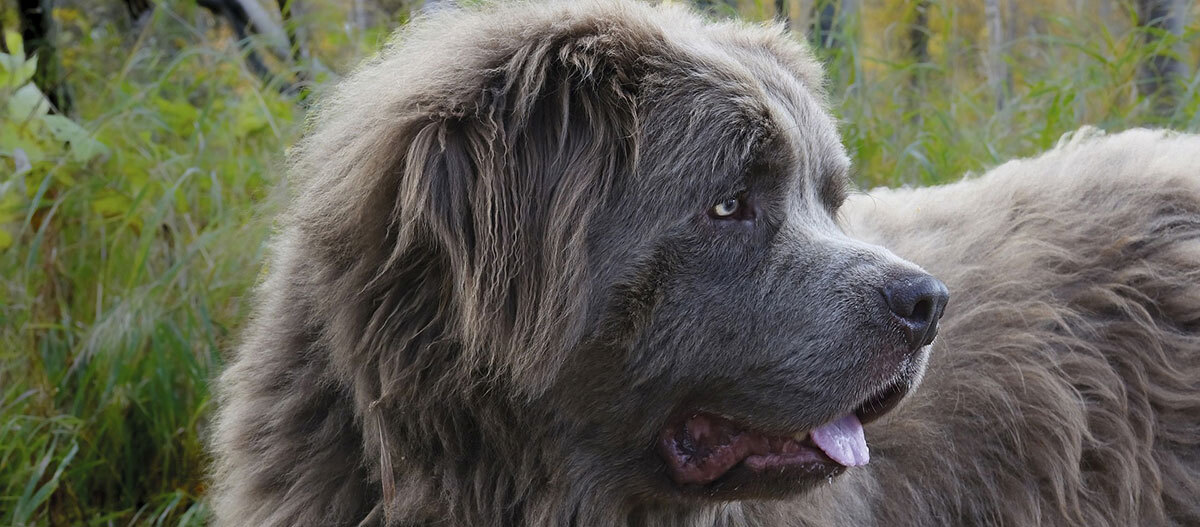
Is a Newfoundland a family dog?
Almost nothing bothers the Newfoundland. As a friendly and peaceful dog, a Newfoundland is therefore the perfect family dog. It can tolerate almost anything from children and as part of the pack, protects them, but without ever acting aggressive towards other people. Due to the size and considerable weight of a fully grown Newfoundland, you are best always keeping an eye on your dog and children, especially with very small children. Otherwise, the chances of a Newfoundland getting on well with other dogs or pets are high.
How much does a Newfoundland puppy cost?
There is no flat rate cost for a Newfoundland – the price can vary from breeder to breeder. But you can expect around €1,400 for a pedigree Newfoundland puppy.
Where can you buy a Newfoundland?
If you are looking to buy a Newfoundland puppy, the price should not be the only consideration. It is far more important to look for an animal from a responsible breeder. But how can you identify a good Newfoundland breeder? A reputable breeder will show you their animals within their own living areas. It goes without saying that you should also be able to meet the puppies’ mother. A Newfoundland puppy (like all puppies) should not be any younger than twelve weeks before being separated from its family. If a breeder answers your questions about their dogs, about their keeping and care, as well as any diseases that may occur, this is also a good sign. Ideally, you will be able to visit the puppies several times before deciding on one of the animals. By contrast, if a breeder pressures you into buying or offers you very young animals, it’s best keeping your distance. The same goes if you are offered puppies at anonymous places, such as at the car in a car park or from a shed. It is highly likely that these are being offered by an illegal puppy dealer. If you think you may have come across an untrustworthy seller, then do not buy one of their dogs under any circumstances – even if you feel sorry for them!
Rescues and Newfoundland mongrels
If you don’t really want to pay for a Newfoundland puppy, a dog protection organisation may be an alternative option. Newfoundland mongrels are also popular – for example, a Newfoundland mix with Landseers or Labrador Retrievers, as well as other larger dog breeds are being seen more frequently. If you are interested in a Newfoundland mix, it is useful to look into the characteristics and needs of the other breed. Ultimately, there is no way to predict which characteristic will stand out most in one individual animal. The same applies to the size if one parent comes from a breed with a smaller body size.
Taking care of a Newfoundland
You guessed it: Due to its special, opulent coat, taking care of a Newfoundland’s fur is very time-consuming. Paying it special care is also important because a neglected Newfoundland coat can develop an unpleasant odour. With Newfoundlands, it is therefore crucial that you brush out and comb its fur carefully to prevent any matting. Pay special attention to the chest, ears and insides of the elbows here. However, you should only bathe the Newfoundland in exceptional cases, such as if it has gotten very dirty. When cleaning your dog, you must use a lipid replenishing bath additive: This allows you to preserve its typical protective film and protect its skin.
What to be aware of when feeding your Newfoundland puppy
With young Newfoundlands, we recommend making sure that their food does not accelerate growth. For dog breeds that grow rather quickly and are big, not only does the energy content of the food have to be right, but also the composition of minerals. The specialist trade offers special puppy food for large dogs. Diet is so important because due to their size and rapid growth, these dogs tend to develop certain orthopaedic diseases. Heart problems can also occur, such as what is known as dilated cardiomyopathy. Simply put, this causes an enlarged heart in the dogs affected, restricting its function. In extreme cases, it can result in sudden cardiac death. Other possible heart diseases can affect the blood vessels near the heart or the cardiac valves. Compared to other dogs, forms of bone cancer (osteosarcoma) are also seen more often in this breed.
How old do Newfoundlands become?
As with many other large dog breeds, the life expectancy of a Newfoundland is relatively low: A healthy Newfoundland lives an average of ten years, but some animals have a lower life expectancy.
